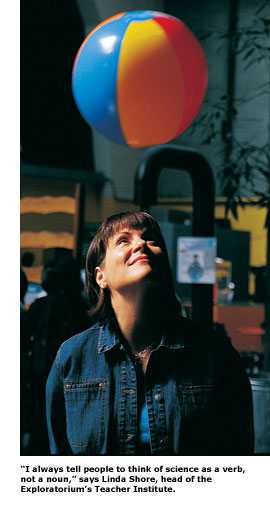 |
| |||
Science in Motion Linda Shore(B.A., '63; M.A.,'86) was planning on a career as a documentary filmmaker when she began her coursework at SFSU, but the microphones got in the way. "I was fascinated with them. I wanted to take them apart and find out how they worked," she says, recalling how she bombarded her broadcast professors with technical questions until one kindly steered her toward a physics class. Shore changed gears to focus on a career as a science teacher, but her objective was the same. "I've always wanted to translate information and help people understand it," she says. Since 1993, she has been helping teachers learn to do just that at the Exploratorium, a hands-on science museum housed in San Francisco's Palace of Fine Arts. The director of the museum's Teacher Institute, Shore leads an internationally recognized program that offers training for those who teach middle- and high-school science. "Rather than teaching students directly, Linda spreads her enthusiasm to teachers, both new and experienced, very tenured -- and possibly -- tired," says Ron Hipschman(B.A., '76; M.A., '82), the webmaster for the Exploratorium. Shore got her earliest teaching experience while working toward her bachelor's degree in physics. She tutored students in math, taught physics and astronomy lab classes and was entrusted with lecture sections of pre-med physics classes at age 24, which makes her among the youngest instructors in the California State University system to do so. Shore went on to earn a master's degree in physics at SFSU before earning her doctorate in science education at Boston University. At the Exploratorium she helps science teachers deal with challenges they face in the classroom. Some may have been asked to teach a branch of science outside of their area of expertise. A common struggle is trying to teach science without funds for school supplies. "Teachers can be given an empty room and told to teach earth science, so a lot resort to lecturing," says Shore, who oversees a staff of 10 science teachers at the Exploratorium. "We stress that you don't need expensive supplies to do powerful science. You can do it with paper clips or [plastic] foam cups." For proof, she suggests viewing an episode of "Iron Science Teacher" on the Exploratorium's Web site. A take-off of the Japanese TV program "Iron Chef," the competition offers science teachers one "ingredient" such as kitty litter, a milk carton or golf ball. Competitors have 10 minutes to invent a science activity that can be used in the classroom. Shore will soon host a competition for science teachers in Texas. "Last time the secret ingredient was a can of Texas chili," she says. "I can't tell you what it will be this time." For more information: www.exploratorium.edu/educate -- Adrianne Bee | ||||










